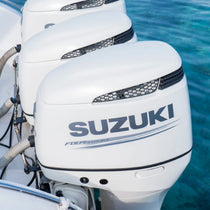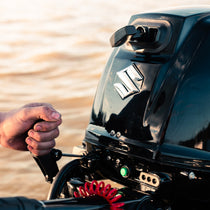Maintaining your Suzuki outboard engine in saltwater environments requires specific care to ensure longevity and optimal performance. Saltwater can be particularly harsh on marine engines, leading to corrosion and other issues if not properly addressed. Following the proper maintenance steps can protect your investment and allow you to enjoy smoother, more reliable boating experiences.
Wash and Wax Your Engine
Keeping your outboard engine clean is more than just about looks. Regular washing and waxing have practical benefits:
- Wash with boat soap and water to remove salt and other deposits that can lead to corrosion.
- Apply good quality marine wax to enhance the appearance while sealing and protecting the finish against harsh sun and salty conditions.
- Use a soft cloth or sponge to avoid scratching the surface while washing.
- Inspect the engine cover and other painted surfaces for signs of wear and reapply wax more frequently in these areas.
Use a Salt-Removing Product
Use a salt-removing product, like Star brite’s Salt Off, to flush your engine or remove salt from your boat’s surfaces, including electronics.
Replace Sacrificial Anodes
Anodes play a vital role in preventing corrosion:
- Check and replace anodes regularly. Your Suzuki anodes protect metal parts from corrosion.
- Replace anodes as recommended in your owner’s manual, or once they degrade to less than 50% of their original size.
- Consider adding an extra anode in highly corrosive saltwater areas. Add an extra anode below the waterline and bond it to the engine with marine electrical wire. Consult your dealer for advice and refer to your Suzuki accessories catalog for parts.
- Inspect all anodes before and after each season to ensure they function correctly and provide maximum protection.
- Clean the mounting surfaces of the anodes to ensure good electrical contact and effective corrosion prevention.
Flush Your Outboard with Fresh Water
After each trip, it's crucial to flush your engine with fresh water. Saltwater residue can cause significant damage if left unchecked. Here's how to do it:
- Use a quality "ear muff" style motor flusher that fits on the lower unit water pick-up or flushing port.
- Run the engine at idle speed (in neutral) for at least 5 minutes to help flush out any salt and other deposits.
- Refer to your owner’s manual for detailed instructions and safety precautions to ensure you perform this task correctly and safely.
- Ensure fresh water is available at your docking site to make this process more convenient and consistent.
Touch Up Nicks and Scratches
Regular inspections can prevent long-term damage:
- Inspect for nicks and scratches regularly. These are spots where corrosion can start.
- Use color-matched touch-up paint for superficial scratches and a top-quality metal primer for deeper ones, especially where bare metal is exposed.
- Keep a touch-up paint kit onboard for quick repairs while on the go.
Store Your Engine Properly
Proper storage is essential to maintain your engine's integrity:
- Avoid direct sunlight. UV rays can damage the finish and deteriorate plastic and rubber components.
- Use a UV-resistant Suzuki outboard cover, especially if direct sunlight exposure is unavoidable.
- Store the engine in a well-ventilated area to prevent moisture buildup and potential mold growth.
Lubricate Key Points
Lubrication prevents corrosion and ensures smooth operation:
- Your Suzuki comes equipped with special grease fittings. Use a grease gun to apply grease through these fittings regularly.
- Remove the propeller periodically and apply a film of grease to the propeller shaft. This step is crucial to prevent the propeller from seizing up and ensures easier maintenance.
- Check the steering and tilt mechanisms and apply grease to ensure smooth and responsive handling.
- Follow the recommended lubrication schedule in your owner’s manual for best results.
Apply Silicone Spray
Saltwater can be harsh on your engine's components. Every second or third trip, take the time to treat your engine:
- Remove the hood (ensure the engine is off and cool) and apply a thin film of silicone spray to the power head.
- Use a silicone spray that is safe for rubber and plastic. CRC brand heavy-duty silicone lubricant (no. 765-1422) is an excellent choice.
- Pay special attention to electrical connections and other exposed components to ensure comprehensive protection.
- Wipe away any excess spray to prevent dust and debris from sticking to the treated areas.
Additional Tips
- Keep your owner’s manual handy for detailed maintenance procedures and safety precautions. It contains essential information specific to your engine model.
- Consult with your dealer for personalized maintenance advice and parts. They can provide insights tailored to your specific usage conditions and local environment.
- Join online forums and user groups for additional tips and shared experiences from fellow Suzuki outboard owners.
- Keep a maintenance log to track your servicing and repairs, which can be helpful for future reference and resale value.
What Should I Do If I Notice Corrosion?
If you notice any signs of corrosion, it's essential to address it promptly. Various methods are available to manage and mitigate corrosion. Regular inspections can help identify these issues early, allowing you to take the necessary steps to prevent further damage. Consult your owner’s manual or seek advice for specific recommendations on handling corrosion effectively.
Regular maintenance not only prolongs the life of your engine but also enhances your overall boating experience. It ensures you spend more time enjoying the water and less time dealing with potential issues. Proper care today means fewer problems tomorrow, making your marine adventures as enjoyable and worry-free as possible.





















